|
Related FAQs: Anemones, Anemones 2, Anemones 3, Anemones 4, Anemones 5, Anemones 6, Bubble Tip Anemones, LTAs, Caribbean Anemones, Condylactis, Anemones &
Clownfishes, Anemones & Clowns 2,
Anemone
Identification, Anemone ID 2, Anemone ID 3, Anemone ID 4, Anemone ID 5, Anemone ID 6, Anemone ID 7,
Anemone ID
8, Anemone ID
9, Anemone ID 10, Anemone ID 11, Anemone ID 12, Anemone ID 13, Anemone ID 14, Anemone ID 15, Anemone ID 16 Anemone ID 17, Anemone ID 18, Anemone ID 19,
Anemone ID
20, Anemone ID 21,
Anemone ID 22, Anemone ID 23,
Anemone ID
24, Anemone ID 25,
Anemone ID 26, Anemone ID 27,
Anemone ID
28, Anemone ID 29,
Anemone ID 30, Anemone ID 31, Anemone ID 32, Anemone ID 33,
Anemone ID 34, Anemone ID 35,Anemone ID 36,
Anemone ID 37, Anemone ID 38, Anemone ID 39, Anemone ID 40, Anemone ID 41, &
Anemone
Behavior, Anemone Behavior 2,
Anemone Compatibility,
Anemone Compatibility
2, Anemone
Selection, Anemone Health,
Anemone Health 2, Anemone Health 3, Anemone Health 4, Anemone Health 5, Anemone Health 6, Anemone Health 8, Anemone Health 9, &
Anemone
Placement, Anemone
Reproduction, Anemone
Systems, Anemone
Systems 2, Anemone
Systems 3, Anemone
Lighting, Anemone Lighting 2,
Anemone Lighting 3,
Anemone Lighting
4, Anemone
Feeding, Anemone Feeding 2, Aiptasia, Other Pest
Anemones, Heteractis
malu,
Related Articles: Heteractis crispa/Sebae Anemones,
Magnificent Anemones, Heteractis malu, Invertebrates, Stinging-Celled Animals,
Clownfishes, Coldwater Anemones,
Bubble Tip Anemones, LTAs, Aiptasia/Glass Anemones, Anemones of the Tropical West Atlantic,
Colored/Dyed
Anemones, Marine Light, &
Lighting,
Water Flow, How Much
is Enough,
/Diversity of Aquatic Life
Series
Anemones in
Captive Systems
Part 1 of
3
Part. 2,
Part 3,
|
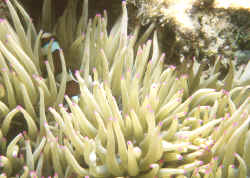
|
|
By Bob Fenner
|
Heteractis
crispa in Cebu, P.I.
|
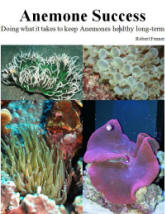 |
New Print and
eBook on Amazon:
Anemone Success
Doing what it takes to keep Anemones healthy long-term
by Robert (Bob) Fenner
|
Flowers of the sea? Hardly. Most anemones are marine; but they are definitely animals, just a step or
two up from the "tissue-grade" life that is the sponges,
phylum Porifera.
The trade in these stinging-celled animals is brisk, and
well it should be; many species are reasonably available and hardy,
undemanding aquarium fare.
This series offers an overview of aquatic life natural
history, and captive care. This installment deals with the polypoid
cnidarians (coelenterates) we call anemones.
Try imagining a reef system, photograph, television show,
fish store without anemones. Hard to do, isn't it? Anemones are
seemingly ubiquitous fixtures in all these.
Why? Many species make hardy specimens given proper collection, treatment and selection (by you).
They have remarkable, interesting biologies. Know though that the vast
majority of specimens aquarists try only live days to a few weeks...
largely due to the trauma of collection, holding, shipping practices
before they get them... and secondarily due to factors such as a lack
of light, inappropriate feeding, being placed in poor water quality,
with incompatible livestock... Much to know before one buys.
Classification: Taxonomy,
Problems
Early classifiers termed anemones "zoophytes"
or animal plants, in reference to their flower-like appearance. Many of
us know them from their old phyletic grouping within the
"Coelenterata, an allusion to their gastro-vascular cavity (coel=
hollow, enteron= intestine). Modern classifications tend to leave out
the comb-jellies (phylum Ctenophora), and group the anemones,
jellyfish, hydras and corals as the phylum Cnidaria, describing their
"possession of stinging-cells" on mouth-surrounding
tentacles.
Within the phylum they are further sub-classified on the
basis of body plan. Anemones are typically polyp-like (polypoid)
cylinders, sessile, with their oral cavities upright. Other forms are
generally medusa-like, free-swimming discs, mouth down.
Most are marine, a few freshwater, some interstitial (in
the substrate!). There are about 9,000 described species. Their fossil
record dates back to earliest life time, the Cambrian period.
Within the Cnidaria, Anemones are placed in the Class
Anthozoa; as single or colonial polyps, the medusoid stage completely
missing. This group includes the bulk of cnidarian species (6000+)
encompassing corals, sea fans, and sea pansies They are distinguished
from the hydrozoans and scyphozoans by the lack of an operculum on
their stinging cells and several structural/embryological
differences.
Anemones are separated from other anthozoans in the
sub-class Zoantharia, and two main orders: The Actinaria are often
called the "true anemones". They have internal separations of
body parts (mesenteries) arranged in hexamerous (six) cycles and
usually with two ciliated oral cavities (siphonoglyphs). The other
order, Ceriantharia, or "tube" anemones have greatly elongate
bodies without basal discs, secreted mucous tubes buried in soft
substrates. One siphonoglyph and complete mesenteries.
Relation with other
groups:
Placed a group above the sponges, Cnidarians are often
grouped with the comb-jellies, phylum Ctenophora as the Radiata, for
their radial symmetry. These are simple animals made of three basic
layers, an outer epidermis, a lining of the gut (gastrodermis) and a
changeable, amorphous inner layer of mesoglea. Cnidarians have little
to no organ development.
Selection: General to
Specific:
As faithful followers of my unending scribblings will
testify, I will not abide nefarious practices in the aquatics trades
and, unfortunately, dear reader, anemones are a "guilty"
area.
Most anemones that die quickly in the hobbyists care were
doomed through mis-collection or rough handling in-between their
purchase. I am referring to physically tearing the body, usually the
disc/foot through hasty separation from the wild substrate or aquarium.
Where removing anemones goes, careful patience is key. Some thoughtful,
conscientious wholesalers (e.g. Phil Shane's Quality Marine) have
hit upon the use of indoor/outdoor carpeting material lining their
tanks to facilitate removal and examination. But, the ultimate damage
born is due to too anxious handling. Carefully, slowly
slide a nail under the disc, around the perimeter to remove a specimen.
Examine and bag same under water! Avoid having anemones or their
"slime" touching your wrists, eyes, other non-calloused
areas, especially mucus membranes Rinse and wipe off your hands.
Most folks can tolerate time to time contact with most offered species;
should you develop a sensitivity, wear thin rubber gloves, or keep your
hands off!
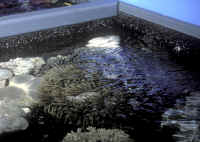 |
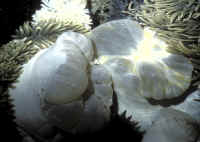 |
| At Quality Marine in Los Angeles, a premiere marine
livestock wholesaler. Anemone holding facilities made of sheet PVC
covered with indoor/outdoor carpeting to allow easy removal,
non-tearing of specimens. Drainage is also concealed to prevent
plugging/clogging... large volumes of water are utilized as
"dilution solution" to large biomass changes. |
High quality specimens to start with, Here are
examples of anemones with intact (non-torn) pedicles and basal
discs. Do inspect the "foot" of all prospective purchases
ahead of buying. |
| Be aware and beware of the too-frequently
badly damaged offering of poor anemone specimens. Shown here is a Heteractis
malu w/ a torn foot/pedicle... Such specimens rarely recover. |
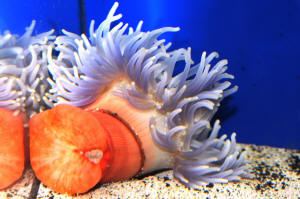 |
Re Colored
Anemones: Yes; tinted, dyed,
artificially colored specimens. "Sebae" and
"Ritteri" anemones in particular are often adulterated with
vegetable (and other) dyes to "enhance" their salability. I
put these (and the people who buy them) in the same box as
"painted" fishes, minnows (Labeo, et
al.), glassfish (Chanda), and (barf) others.
No, the "pretty" color does not last and no, I cannot see how
it adds to the organism's vitality. There are naturally colored anemones.
Healthy specimens have long, fully
expanded tentacles and a semi-clean earthy/marine smell. Dead, dying
specimens smell bad.
If you are comfortable with the varieties you'd like
and how you will care for them, specimens can be bought at local
outlets, ordered through the mail/phone or even collected from the wild
if not too dear or restricted by law. I offer my usual advice for
purchase. Inquire as to origin, history on-site... and put down a
suitable deposit, retrieving the individual(s) in a week or two. This
will weed out the vast majority of doomed/damaged specimens and afford
other folks the opportunity of viewing.
Anemones Naturally Symbiotic With Clownfishes:
| Cryptodendrum adhaesivum Klunzinger 1877,
the Adhesive Sea Anemone, aka as the Pizza Anemone for obvious
reasons. Family Thalassianthidae. Not often seen, used in the
aquarium interest due to the species extremely sticky short
tentacles and propensity for tearing in moving. Only one Clownfish
species is found in it in the wild, the Clarkii. At right in Nuka
Hiva, Marquesas, often found with juveniles of the endemic
Dascyllus strasburgi. Below: A specimen in Pulau Redang,
Malaysia, and one with a Periclimenes brevicarpalis symbiont
in Fiji, a close-up of one and the same shrimp species symbiont off
Queensland, Australia. |
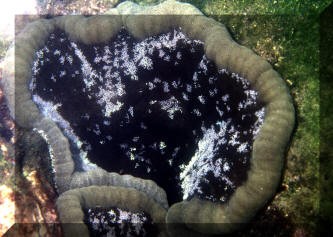
|
Bigger PIX:
The images in this table are
linked to large (desktop size) copies. Click on "framed"
images to go to the larger size. |
%20MD.JPG)
%20MD.JPG) |
| Entacmaea quadricolor (Ruppell
& Leuckart 1828), the Bubble-Tip or Bulb-Tentacle Sea
Anemone. Family Actiniidae. This is historically the hardiest
of large, naturally symbiotic Clownfish anemones for aquarium
use... many more specimens are collected and received in tact, in
reasonably good health from the wild to distributors. And more
and more folks are offering very hardy "fragged"
individuals that are asexual cloned aquacultured specimens. A
colonial grouping and a close-up image of the Bubble-Tip Anemone
and the Clownfish, Amphiprion bicinctus in the Red Sea and
Fiji, and unusual colored specimens in Pulau Redang, Malaysia and
Fiji. |
| Verticals (Full/Cover Page Sizes
Available) |
.JPG) |
| Gyractis sesere (Haddon &
Shackleton
1893),
Looking more like Zoanthids, but closer to Anemonia majano. Aq. photo. |

|
| Heteractis aurora (Quoy & Gaimard
1833),
the Beaded Sea Anemone. Family Stichodactylidae. Up to two
inch tentacles, eleven inch disc width, with characteristic beaded
appearance. With apparent mouth opening and often with radiating
appearance from center. Stalk may be mottled or solid orange or
red. Live attached to solid structure, able to retract completely
beneath the substrate. Full size and close up Malaysian
images. |
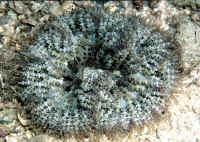 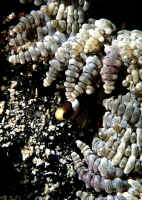
|
Bigger PIX:
The images in this table are
linked to large (desktop size) copies. Click on "framed"
images to go to the larger size. |
%20MD.JPG)
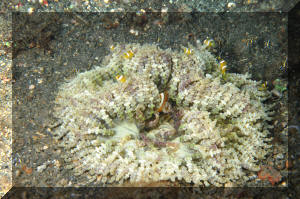
MD.JPG) MD.JPG)
%20MD.JPG)
%20MD.JPG)
%20MD.JPG)
%20MD.JPG) |
| Heteractis crispa (Ehrenberg 1834), the
Leathery or Sebae Sea Anemone. Family Stichodactylidae. Often
mis-sold/identified in the trade as H. ritteri and the
commonest species in the market as the "Sebae Anenome".
Has numerous long, tapering tentacles that end in points. Column
gray in color. A close-up in Fiji, the second in the Cook Islands,
third in Fiji. See more typical aquarium specimen above in the
article header. Click colored, linked names/files for much more. |
| Heteractis
magnifica (Quoy & Gaimard 1833), the Magnificent Sea
Anemone. Family Stichodactylidae. Found in open areas, attached to
a solid object. Base of solid purple, blue, green, red, white or
brown color. Oral disc flat with barely tapering, finger-like
tentacles up to a meter across. Specimen showing disc and
basal color and in Pulau Redang, Malaysia at right. And a
close-up of the pedicle (stalk) of one in N. Sulawesi to show the
verrucae. |
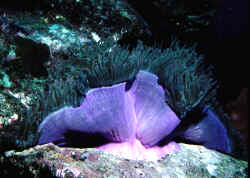
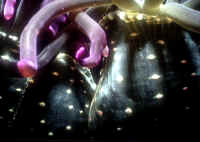
|
| Heteractis malu (Haddon & Shackleton
1893), the Delicate Sea Anemone. Narrow, buried column of pale
cream, yellow, orange to red color, sometimes with some yellow or
orange splotching. Upper part with adhesive verrucae in rows.
Sparse tentacles of stubby appearance, variable length, usually
magenta tipped, with radial markings. Found in sediment in shallow,
still water. Here in Australia with a Clarkii Clownfish and at a
wholesalers. |
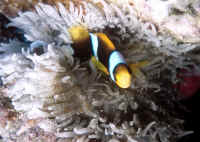 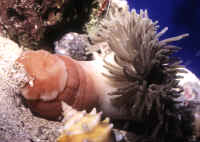
|
Bigger PIX:
The images in this table are
linked to large (desktop size) copies. Click on "framed"
images to go to the larger size. |
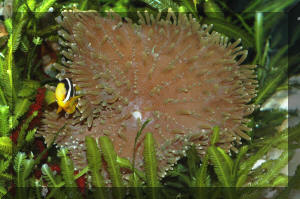
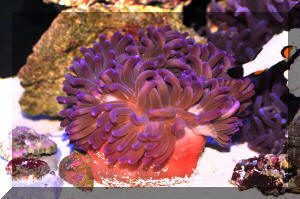
%20MD.JPG) |
| Macrodactyla doreensis
(Quoy & Gaimard 1833), the Corkscrew Tentacle Sea Anemone, Long
Tentacle Anemone (LTA), Sand, Red Based... Anemone. Column colored
dull orange to red on lower part, to white above, buried in
sediment that it can completely retract into. Oral disc flared
widely, with few, but long sinewy, tapering, corkscrew-like
tentacles. Distinctive
(eye-like) verrucae in rows Disc often with radial
appearance. In N. Sulawesi typically w/o fishes, in the mud, and in
captivity. |
Carpet
Anemones: Named for their immense size (sometimes more than a
meter/yard across) and "pile"; numerous colored tentacles.
Very difficult aquarium specimens that "shed", otherwise
can/do sting and poison tankmates.
| Stichodactyla gigantea
(Forsskal 1775), the Gigantic (Carpet) Anemone. Family
Stichodactylidae. Has characteristic deeply folded oral disc, with
short, tapering, blunt tentacles. Often found attached via a
relatively narrow column to something solid while surrounded by
sand in very shallow water. Come in browns, blue, green, pink,
purple tentacle colors. A specimen in Indonesia, a beautiful blue
one in Fiji and a close-up in captivity. |
| Stichodactyla haddoni
(Saville-Kent 1893), Haddon's (Carpet) Sea Anemone. Family
Stichodactylidae. Variably folded disc surface, open near surface.
Has a tentacle-free central area. Very small tentacles with narrow
stalks, globose ends; often vary in color. Have larger columns...
Lives in sand in which it can/does completely retract when
disturbed. Close up and overall images of aquarium
specimens. |
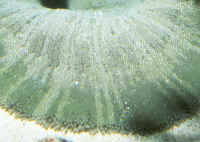 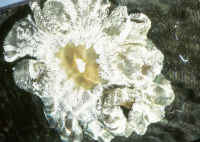
|
| Stichodactyla mertensii
Brandt 1835, Merten's (Carpet) Sea Anemone. Family
Stichodactylidae. Folded disc exceeding a meter in diameter in some
specimens. Lives on hard surfaces that it covers closely. Small
pedal disc, striated by disc-spreading verrucae of orange or
magenta color. Short tentacles (1cm) of uniform color. Have narrow
columns of grey to white color. Close up and further back on
specimens in Pulau Redang, Malaysia. |
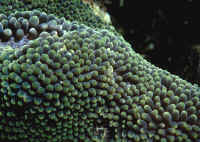 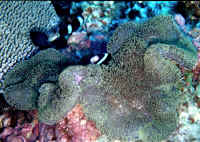
|
Naturally Symbiotic Relationships Between Amphiprionines
and Actinarians (After Fautin 1997)
<Note: In captivity Clownfishes will often come to be associated with other
species, even inanimate objects!>
#1 Cryptodendrum adhaesivum, #2 Entacmaea
quadricolor, #3 Heteractis aurora, #4 Heteractis
crispa #5 Heteractis magnifica, #6 Heteractis malu,
#7 Macrodactyla doreensis, #8 Stichodactyla gigantea, #9
Stichodactyla haddoni, #10 Stichodactyla
mertensii
| Clownfish/Damsel Species/Anemone #
as above |
1 |
2 |
3 |
4 |
5 |
6 |
7 |
8 |
9 |
10 |
| A. ephippium, Red Saddleback
Clownfish |
|
X |
|
X |
|
|
|
|
|
|
| A. frenatus, Tomato Clownfish |
|
X |
|
|
|
|
|
|
|
|
| A. fuscocaudatus, Seychelles
Anemonefish |
|
|
|
|
|
|
|
|
|
X |
| A. latezonatus, Wide-Band Anemonefish |
|
|
|
X |
|
|
|
|
|
|
| A. latifasciatus, Madagascar
Anemonefish |
|
|
|
|
|
|
|
|
|
X |
| A. leucokranos, White-Bonnet
Anemonefish |
|
|
|
X |
X |
|
|
|
|
X |
| A. mccullochi, McCulloch's
Anemonefish |
|
X |
|
X |
|
|
|
|
|
|
| A. melanopus, Red & Black
Anemonefish |
|
X |
|
|
X |
|
|
|
|
|
| A. nigripes, Maldive's
Anemonefish |
|
|
|
|
X |
|
|
|
|
|
| A. ocellaris, False Clown Anemonefish |
|
|
|
|
X |
|
|
X |
|
X |
| A. omanensis, Oman Anemonefish |
|
X |
|
X |
|
|
|
|
X |
|
| A. percula, Clown Anemonefish |
|
|
|
X |
X |
|
|
X |
|
|
| A. perideraion, Pink Anemonefish |
|
|
|
X |
X |
|
X |
X |
|
|
| A. polymnus, Saddleback Anemonefish |
|
|
|
X |
|
|
X |
|
X |
|
| A. rubrocinctus, Australian
Anemonefish |
|
X |
|
|
|
|
|
X |
|
|
| A. sandaracinos, Orange Anemonefish |
|
|
|
X |
|
|
|
|
|
X |
| A. sebae, Sebae Anemonefish |
|
|
|
|
|
|
|
|
X |
|
| A. thiellei, Thielle's
Anemonefish |
|
|
|
|
|
|
|
|
|
|
| A. tricinctus, Three-Band Anemonefish |
|
X |
X |
X |
|
|
|
|
|
X |
| Premnas biaculeatus, Spine-Cheek
Clown |
|
X |
|
|
|
|
|
|
|
|
| Dascyllus trimaculatus, Domino Damsel |
|
X |
X |
X |
X |
|
X |
X |
X |
X |
|
|

